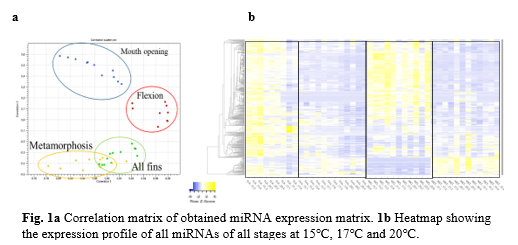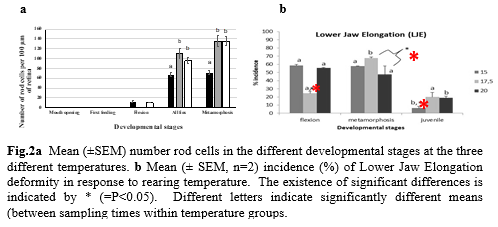INSIGHTS FROM HIGH THROUGHPUT NON-CODING RNA SEQUENCING DURING EUROPEAN SEA BASS DEVELOPMENT REARED AT DIFFERENT TEMPERATURES
Introduction
The European seabass (Dicentrarchus labrax) is one of the most extensively cultured species in European aquaculture productions. Environ mental effects on the well-being of organisms and especially in teleost have been demonstrated within a broad range of studies. In particular, the temperature is known to control every biological function in such organisms [1] , especially during early larval development, and can have both direct effects, such as on the growth rate, the development of skeletal deformities, but also indirect effects, such as on sex differentiation and the final sex ratio of the populations in fish with temperature-dependent sex determination system (TSD). Previous studies in the European sea bass have shown the existence of TSD [
. Besides the significance of sex control in aquaculture influenced by environmental factors, embryonic and larval stages represent one of the most critical periods to ensure high performance and superior quality in the subsequent developmental phases of the life cycle. Key developmental events occur early in development and are influenced by external parameters such as stress, temperature, salinity, and photoperiod. Any failure may cause malformations, developmental delays, poor growth, and massive mortalities.
Here we report the influence on miRNAs at three different temperatures during the European sea bass development.
Material and methods
Ethical approval for the study was obtained by the relevant Greek authorities (National Veterinary Services ) under the license No 255368 (ΑΔΑ: 6Λ4Σ7ΛK-ΩΜΥ). Samples of larvae were collected at the following developmental stages : mouth opening , flexion , all fins, and metamorphosis, and total RNA extraction was carried with the use of the Nucleospin miRNA kit (Macherey -Nagel, Duren, Germany ) following the manufacturer’s instructions. miRNA libraries were generated using the NEBnext multiplex Small RNA Library Preparation and sequenced over 4 lanes on the Illumina NextSeq sequencing platform at the Microchemistry laboratory of Forth , Crete , Greece . Samples at the same developmental stages were also collected for eye development evaluation and were preserved in 4% formaldehyde:1% glutaraldehyde until histological analysis . For skeletal deformities evaluation , during the samplings , which were conducted at the flexion and the metamorphosis stages , specimens were anesthetized with ethylene glycol-monophenylether (Merck, 0.2–0.5 ml l_ 1), fixed individually in phosphate-buffered 5% formalin, and stored in the dark at room temperature before staining .
Results
In total, 654 million seq uencing reads were obtained, with an average of 13 million reads per sample. A correlation matrix based on read counts was generated (Fig.1a) was generated. Expression profiles of all stages at 15℃, 17℃, and 20℃ were assessed (Fig.1b). Stages are ordered according to their respective developmental time course confirming correct staging during sampling.
Temperature differences were detected mainly between 15℃ versus 20℃ (203) and 17℃ versus 20℃ (145) in the metamorphosis stage. The flexion stage reveals to be of special interest since no differential expression was detected between the temperature 15℃ and 20℃ but between 15℃ and 17℃ (321) as well as between 17℃ and 20℃ (299). T he same phenoma has been observed in the development of rod cells in the eye as well as in the lower jaw elongation..
Discussion and conclusions
The present study showed clearly the importance of miRNA concerning temperature changes in early developmental stages. The main stages being influenced by temperature are the metamorphosis as well as the flexion stage. Identified miRNAs are found to be largely regulating genes belonging to the immune response. This finding may indicate that changes in temperature influences the immune system. The particularity of the flexion stage may comprise the first indications that during this stage the gender may be determined since identified miRNAs are found to regulated sex-determining genes. Future research will be focused on the evaluation by functional studies of expressed differentially miRNAs according to temperature changes and their putative target.
References
- Anastasiadi D, Díaz N, Piferrer F. Small ocean temperature increases elicit stage-dependent changes in DNA methylation and gene expression in a fish, the European sea bass. Sci. Rep. 2017;7.
- Vandeputte M, Dupont-Nivet M, Chavanne H, Chatain B. A polygenic hypothesis for sex determination in the European sea bass Dicentrarchus labrax . Genetics. 2007;176:1049–57.
- Mylonas CC, Anezaki L, Divanach P, Zanuy S, Piferrer F, Ron B, et al. Influence of rearing temperature during the larval and nursery periods on growth and sex differentiation in two Mediterranean strains of Dicentrarchus labrax. J. Fish Biol. 2005;67:652–68.
Funding: This study was carried out within the MedAid project, funded by the European Union in the frame of Horizon 2020, grant agreement number 727315.

